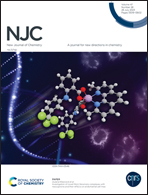Nanoporous silicon photocathodes with [Co] molecular catalyst for enhanced solar-driven hydrogen generation†
Abstract
Silicon (Si) is a commercially available semiconductor used for photoelectrochemical (PEC) hydrogen production, which has various advantages of earth-abundant element, non-toxicity, broad absorption of the solar spectrum, high saturation current and industrial applicability. However, it suffers from surface light reflection, short carrier-transport distance, slow charge transfer at the electrode–electrolyte interface, and poor stability in aqueous electrolytes, resulting in decreased photocurrent density and elevated overpotential. In this work, a surface-modified nanoporous Si photocathode, called black Si (b-Si), was fabricated with a large electrochemical surface area for loading of Co(dmgH)2(py)Cl catalyst. Under the illumination of simulated sunlight, the optimal b-Si/[Co] photocathode exhibited a high photocurrent density of −4.15 mA cm−2 (0 VRHE), a value 319 times that of the f-Si electrode under the same conditions. Moreover, the onset potential positively shifted to 0.31 VRHE and the driving force required for H2 production was significantly decreased. The enhanced water splitting was attributed to the rapid transfer of charge across the electrode–electrolyte interface and efficient HER reactivity via the [Co] molecular catalyst. The surface engineering of the nanoporous structure and the deposition of molecular catalyst on the Si electrode have provided insights into the construction of semiconductor/catalyst hybrid photoelectrodes, and were concluded to synchronously improve the charge transfer at the electrode/electrolyte interface, reduce the overpotential, and speed up the PEC water splitting.
![Graphical abstract: Nanoporous silicon photocathodes with [Co] molecular catalyst for enhanced solar-driven hydrogen generation](/en/Image/Get?imageInfo.ImageType=GA&imageInfo.ImageIdentifier.ManuscriptID=D3NJ02691D&imageInfo.ImageIdentifier.Year=2023)


 Please wait while we load your content...
Please wait while we load your content...